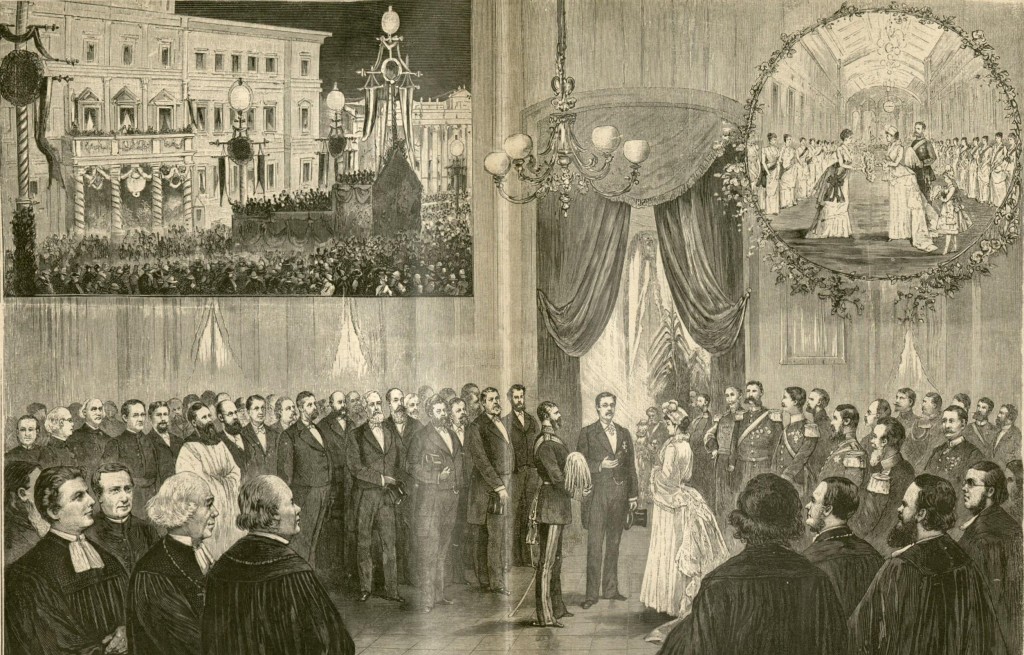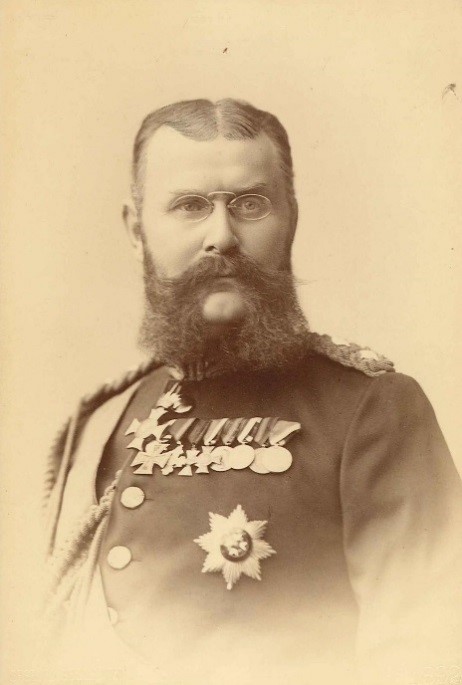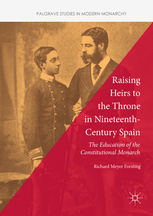Swabian Loyalty and the Uses of Gefühlspolitik
Frank Lorenz Müller
Nineteenth-century narratives of patriotic self-praise are not exactly a genre characterised by originality. When strutting its virtuous stuff, almost every community claimed the same set of great qualities for itself and went on to regard them as typically French or British, Prussian or Bavarian. A trope that was routinely invoked in monarchical states or nations was the characteristic loyalty of the people, a steadfast and faithful adherence to their ruling house that constituted a fair quid-pro-quo for what was purported to be the dynasty’s unceasing dedication and love for its subjects.
The people of Württemberg were no exception. If anything, for the Swabians, the unqualified loyalty they were convinced to have shown their princes over the centuries was a matter of particular pride. This admirable character trait was at the heart of the poem “Preisend mit viel schönen Reden” which emerged as Württemberg’s unofficial anthem in the middle of the nineteenth century. Penned by Justinus Kerner in 1818, the verses describe a scene alleged to have taken place during a get-together of the greats of medieval Germany. While feasting during an imperial assembly in 1495, a posse of dukes were said to have indulged in a bout of one-upmanship as to whose realm was the most precious. After the Saxon, the Bavarian and the Rhinelander had finished bragging about their respective silver mines, monasteries and vineyards, it was the turn of the bearded Count Eberhard, “Württemberg’s beloved lord”. He put them all to shame. Notwithstanding the poverty of his native land, it still held the greatest treasure, he claimed: For “in the forests, though so vast/I can boldly rest my head/In the lap of every subject”. Faced with such a gemstone of loyalty the other princes sportingly conceded defeat and declared Eberhard the richest of them all.
It will come as little surprise that Count Eberhard’s nineteenth-century successors, now elevated to the rank of kings of Württemberg, found much to like in this story, which Kerner’s poem had carried into countless songbooks and classrooms. In 1876 King Karl I of Württemberg (1823-1891) commissioned the sculptor Paul Müller to create a monument depicting the famous scene. The granite ensemble was unveiled in 1881 to mark the 75th anniversary of the foundation of the kingdom and, judging by the write-up in the Württemberg State Gazette, King Karl was pleased with what the artist had crafted: “Paul Müller has boldly realised [Eberhard’s] princely words by showing how the count, caught by the darkness after the hunt is resting in the lap of a shepherd, who is faithfully watching over his slumbering master.” Installed in the capital’s palace gardens, the bearded Eberhard has edified the good people of Stuttgart ever since.
Something was to happen in the autumn of 1889, though, that cut the loyal Swabians to the quick. “A grieving Württemberg has to cover its head in shame”, the Württembergische Landeszeitung lamented on 22 October; “the proud boast of each one of its princes since the Bearded Eberhard … yesterday has made it untrue; the book of Swabian history has been soiled by a shameful stain.” Stuttgart’s Neues Tageblatt initially found the news of the deed downright incredible and even more so, “that a child of Württemberg should have carried it out.” On 23 October the paper reported a comment made by an unnamed farmer, who flatly refused to believe what he had been told: “We have read and witnessed that the Prussians and Italians shoot their princes, but no-one has ever wanted to kill a Württemberger. It could only have been done by a foreigner.”
Sadly, though, for this proud Swabian, the inconceivable had really happened: Martin Müller, a fellow-Swabian, had fired a gun at Prince Wilhelm (1848-1921), the heir to the throne of Württemberg. Just as the prince and his eleven-year old daughter were leaving Marienwahl mansion at Ludwigsburg to attend Sunday service at a nearby church the assassin had stepped up to the carriage and discharged his revolver. Müller’s shot had gone wide and the would-be assassin was immediately apprehended, but grievous damage had been done to the cherished image of flawless loyalty.
It came as some small comfort, though, that the gunman – in spite of initial claims that religious motivations had driven him to his deed – was certified as mentally ill. “The old and tested Swabian fidelity is, thank God, untainted now,” the Schwarzwälder Bote breathed a sigh of relief, “for the deed of a madman can surely not demean an honest, faithful people.” Moreover, to be on the safe side, the Württembergers put on an impressive performance of collective loyalty: books were laid out in which people could inscribe their congratulations to the prince on his narrow escape; a torch-lit parade was held to mark the occasion; people travelled to Ludwigsburg to be near Prince Wilhelm’s mansion and messages of gratitude poured in from across the kingdom.
Even in the nineteenth century – long before Rahm Emmanuel exhorted us never to let a crisis go to waste – it was already understood that something good could even come out of as undesirable an event as the deed of this deranged gun slinger. Only a few days after Müller had fired the shot, Carl von Tauffkirchen, the Bavarian envoy to Württemberg made an interesting observation. He calmly concluded that “the most significant consequence of the assassination was an immense increase in Prince Wilhelm’s popularity”. Tauffkirchen’s analysis went even further: “If such an increase is already the regular and natural result of any such criminal attack,” the envoy argued, “then this had to be even more the case after this specific incident, since the attitude of His Royal Highness was an entirely admirable one.” Prince Wilhelm’s response to the assassination attempt was not merely admirable, but showed a fair amount of political nous. He personally visited Martin Müller in prison and calmly interrogated him about his motives; he comforted the assassin’s distraught brother; he mingled with the well-wishers and he rewarded the affection shown by the inhabitants of Ludwigsburg with a financial gift to benefit the town’s poor. And, of course, none of these actions remained unreported.
Amongst the many things Wilhelm did in the wake of the assassination attempt, one characteristic gesture stood out. Immediately after his return from the church, the Schwäbische Kronik reported, the prince had commented on the fact that the assassin had chosen a moment, when Wilhelm had been accompanied by his daughter Pauline, rather than attacking him when he was alone. Wilhelm returned to this point when interviewing Müller. “Did you not consider that you could have hit and killed the child, my daughter?” the Neues Tageblatt quoted the prince, whereupon the assassin “fell silent and looked to the ground.” The royal father’s concern for his daughter was also reported by the Tübinger Chronik and Tauffkirchen counted the reference to his “innocent child” amongst the list of actions that won Wilhelm everyone’s heart.
Casting himself as a loving and concerned parent who knew the meaning of loss was not a new departure for the heir to the Württemberg throne. In February 1877 the 29 year-old Prince Wilhelm married Princess Marie of Waldeck and Pyrmont. The people of Stuttgart gave the newlyweds a rapturous welcome.
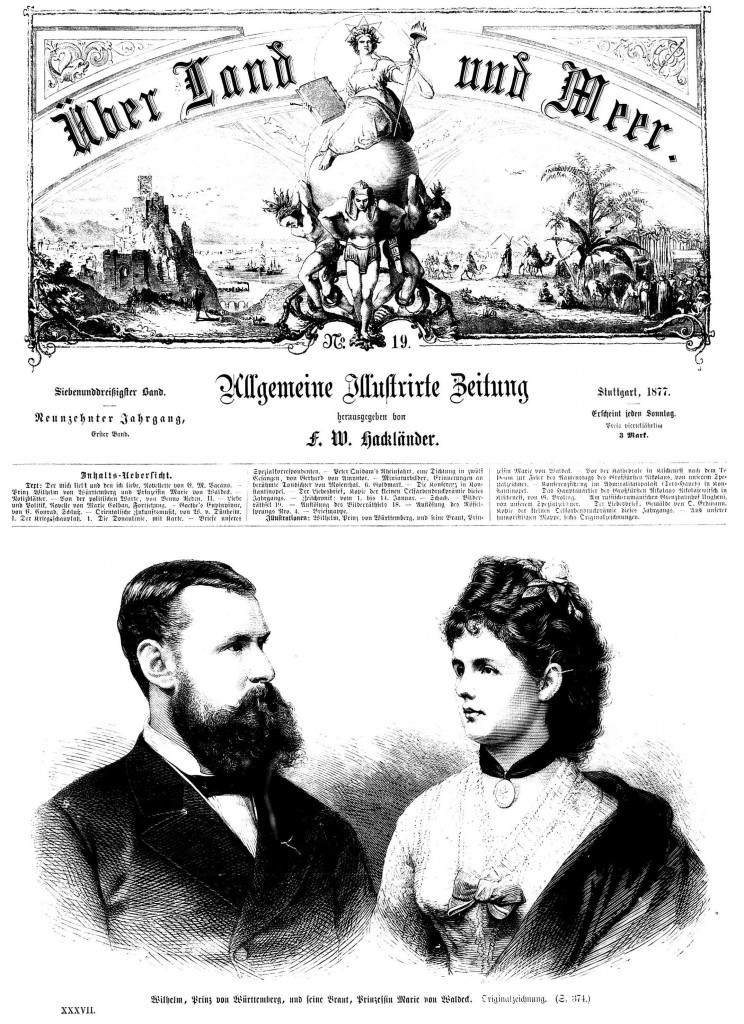
Stuttgart’s illustrated weekly “Über Land und Meer” marks the marriage of Prince Wilhelm and Princess Marie in 1877
Ten months later, Princess Marie gave birth to a healthy daughter, Princess Pauline. The couple’s happiness seemed complete when, in July 1880, their son Ulrich, destined to be the future king, was born. “Imagine the innermost joy of the happy parents”, the Schwäbische Kronik rejoiced; “that joy is generally shared here. Already flags are flying over much of the city.” The Neues Tageblatt reported that a deputation from Ludwigsburg, which had travelled to Stuttgart to offer the town’s congratulations, got to meet the prince in person: “His Royal Highness most graciously spoke to them for some time and delighted them with the news that mother and child were in excellent health.”
Wilhelm and Marie’s happiness was not to last, though. The whole country shared in the pain inflicted by young Ulrich’s sudden death five months later. “The sympathy of the people of Stuttgart is great”, the Prussian envoy reported on 28 December 1880. “Over the last two days the drive to the princely palace was never empty of people of every class, who had come to confirm the sad news which had travelled through Stuttgart at lightning speed.” Both parents were almost paralysed by grief. In a letter to his friend Detlef von Plato Prince Wilhelm described his life as bleak and joyless and wondered if death were not the preferable option. Their daughter was now the only consolation for him and his wife. But much worse was to come. In April 1882, after a long labour, Marie gave birth to a stillborn daughter and then died herself of complications three days later. Prince Wilhelm was so shocked and broken after these tragic events that observers wondered if he might have suffered a stroke and may not survive. Eventually he recovered physically, but the emotional damage was immense. “My whole life is broken, shattered. If I were allowed to do so, I would best like to throw it away”, he admitted to Plato in June 1882. “I have to continue with this tortured existence, though, for my poor, motherless child, this sacred legacy, the only thing that I have left.”[1]
True to his word, the prince – although he withdrew as much as he could from his public and the military duties he had never enjoyed – remained committed to this sacred legacy and took modest steps in the direction of a politics of memory. In December 1882, the Schwäbische Kronik commented on the “touching manner in which the memory of the royal unforgettable Princess Marie was being renewed in the villages [around Ludwigsburg].” Just as it had been Marie’s practice personally to deliver lavish Christmas gifts to the poorest widows and their children, so the princely carriage also arrived this year so that they would receive their “carefully chosen presents from the hands of the little princess [Pauline].”
In the spring of 1883, in time for the first anniversary of Marie’s death, a beautifully designed memorial book was published entitled “Dedicated to the Memory of Her Royal Highness the Prematurely-Deceased Princess Wilhelm of Württemberg”.[2] The short hagiography, written by an anonymous author, told the story of a saint-like young princess, wife and mother whose early death destroyed “an uncommonly happy family”. The reader is told that, before passing away, Marie had offered “her deeply dejected husband words of refreshing consolation.” There was also praise for Marie’s own parents, who had also coped with the loss of a child: “It is admirable how the princely parents dedicated themselves to the education and upbringing of their children with undiminished zeal.” The parallel with Wilhelm’s admirable dedication to his own daughter was hard to miss. Count Tauffkirchen certainly believed that the book was of some interest in that “even if it was not fully written by H. R. H. Prince Wilhelm, it was initiated by him and based on information he provided.” The Bavarian diplomat noted further that the publication had “made a profound impression in the whole country.”
In the long run, the role of the loving father and grieving widower did not, however, prove sufficient for a royal heir not yet in his forties. In 1886 Prince Wilhelm finally had to give in to the mounting pressure from the public, the king and the government and re-marry.
The ever-informed Tauffkirchen reported to Munich that Hermann von Mittnacht, the country’s long-standing chief minister, had urged the prince on several occasions to take this important step in the interests of the kingdom. So when the news of his engagement to Princess Charlotte of Schaumburg-Lippe broke in January 1886, the State Gazette pointed out that an earnest desire of the king had now been met. “The hearts of everyone were rejoicing and offered the prince thanks for his decision, with which he fulfilled an urgent wish of the whole country”, the Schwäbische Kronik added in April 1886. Stuttgart once again laid on a grand reception when the princely couple entered the capital of Württemberg. In his almost painfully elaborate address Lord Mayor Theophil von Hack explained that the “manifold demonstrations with which the capital seeks to welcome Your Royal Highnesses are an attempt to express the wish that the union of the hearts, which your Royal Highnesses have entered, is and remains a wellspring of unchangeable happiness, an eternal fountain of the richest blessings.”
The Württemberg public had every reason to rejoice in the purity and sincerity of the couple’s love. In an attempt to explain why he was taking his time to re-marry, Wilhelm had put his beliefs in this regard on record and emphatically declared himself an opponent of merely dynastic marriages. “I have never lost sight of what I owe to my position as prince and to my country,” he explained, “but I was too happy with my first wife to render myself unhappy for the rest of my life with a marriage of convenience; one cannot even expect a prince to endure that. I do not wish to give my country the example of a cold, loveless marriage! I think too highly of this holy estate to wish to de-sanctify it in this way and thereby to debase myself.”[3] The reality behind the beautiful façade and the soaring rhetoric was less edifying, though. Wilhelm had clearly done what was expected of him and keeping up the appearance of a happy married life with a woman he did not love soon proved hard work.
Within months of his second wedding he despaired of “this comedy that I have to perform in front of the world, always making coquettish jokes, it often makes me want to crawl up the walls.” But the main thing was, he concluded, that they succeeded in presenting the image of a tenderly loving couple. Before too long rumours about the true nature of the prince’s marriage began to make the rounds and there was even talk of Wilhelm having an improper relationship with the wife of his chamberlain, but – on the whole – the matter was covered up successfully. “We show ourselves together in the theatre, drive and walk together, if we feel like it”, he told Plato the following year. “But, but!! – If only I had never met her; she would have led a happy life alongside someone else, and I would at least have gone my own way quietly and – over time – even contentedly.”[4] In terms of its public effect the arrangement worked well, though, and many pious and dignified words were spoken when the couple celebrated their Silver Anniversary in 1911.

Still sombre after all those years: a postcard marking Wilhelm and Charlotte’s Silver Anniversary in 1911 (Peter Schnorr, via Wikimedia Commons)
By the time the deranged Martin Müller discharged his pistol at him in 1889, Prince Wilhelm had thus already had plenty of opportunity to gain experience with what Ute Frevert has called Gefühlspolitik (Politics of Emotion): a politics engaged with emotions and directed at emotions, where “affective perceptions and attitudes are not motives, but resources, tools and objects of political action.”[5] Little wonder, then, that the prince’s response to the attempt on his life was so sure-footed. Moreover, pegging out Gefühlspolitik as his field of activity was a shrewd choice for the heir to the Württemberg throne: it suited the place, the time and the man.
By the 1880s, Württemberg’s crown was in fairly choppy waters. Like the other small and medium size monarchies that had joined together to form the German Reich in 1871, the kingdom of Württemberg and its monarch had to accept a significant diminution of their sovereign rights. Notwithstanding the official doctrine that the twenty-five ‘allied governments’ formed the Reich’s ‘collective sovereign’[6] and governed jointly through the federal council (Bundesrat), the restrictions placed upon the separate states and their rulers marked a sea change. By forming the German Reich its members lost important elements of their sovereignty – most obviously in the fields of foreign and military policy – and this hit no-one harder than the non-Prussian sovereigns. According to the constitutional historian Hans Boldt, there was only one ruler in the Reich who was a monarch ‘in the full meaning of the word’: the German Kaiser.[7] For the other crowned heads the most Bismarck’s tact, constitutional prestidigitation and occasional bribes could achieve was to sweeten the bitter pill of a fundamental shift from a federation of states (Staatenbund) to a Prussian-dominated federal state (Bundesstaat). As princes within the Reich the smaller German monarchs simply had less to decide. This discredited the monarchical element, the historian Heinz Gollwitzer has observed, since every intelligent citizen wondered whether there was still a case ‘for the maintenance of a constitutionally legitimised claim of sovereignty by small and miniscule dynasts’.
King Karl I of Württemberg, who reigned from 1864 until his death in 1891, was one of the German monarchs who never fully came to terms with their reduction in status. Württemberg, an ally of Austria, was defeated by Prussia in the war of 1866, and its king played a noticeably unenthusiastic part in the Prussian-led foundation of the Reich that accompanied the Franco-Prussian War of 1870/71. Like the king of Bavaria, Karl of Württemberg decided to stay away from the proclamation of the new German emperor at Versailles. His reluctant and increasingly frustrated attitude to the new state of affairs certainly contributed to his tendency to withdraw from his duties and increasingly also from his country. Citing ill health, the king spent longer and longer periods in Italy or the South of France and began to feel like a stranger in his own capital. By the end of the 1880s the problem of Karl’s absenteeism and unwillingness to fulfil his routine duties was compounded by a series of scandals involving the king’s penchant for close friendships with good-looking young men of dubious repute. Soon politicians and diplomats spoke earnestly about the irreparable damage this was doing to the monarchical principle and even the press was beginning to weigh in. King Karl, the Münchner Neueste Nachrichten observed in October 1888, had grown “distant from his people, whose monarchical loyalty has been praised in song and history since the days of yore.”
As heir to the throne, Prince Wilhelm had increasingly been called upon to deputise for the absent king on formal occasions. He did so without obvious enthusiasm, tried hard to protect his private life and assumed anything but a proactive role in tackling the crisis that was beginning to engulf his predecessor’s reign.[8] For this attitude Wilhelm was criticised not just internally – with Prussian diplomats frequently complaining about his alleged lethargy and lack of action – but also more widely. The people are worried to see, the Münchner Neueste Nachrichten observed, that Wilhelm “showed a strong tendency towards seclusion and loneliness.”
The paper need not have worried, though, for Wilhelm’s reign turned out to be remarkably successful. Unlike his predecessor, Wilhelm, who had served with a Prussian regiment, did not chafe too badly under the yoke of the Reich, but readily accepted the new reality of a German nation state and presented himself as both a good German and a father to his Swabian people. Nor did he – unlike his namesake on Germany’s imperial throne or Bavaria’s ill-fated King Ludwig II – entertain any anachronistic ideas about wanting to exercise a personal monarchical regiment and oppose the development towards an increasingly constitutional monarchy.
Rather, as was indicated by the promise he gave upon his accession in 1891 – to strive for „steady and prudent progress in every area of the life of the state” – King Wilhelm II was content to accompany an organic development with a reassuring monarchical presence. The new monarch soon cultivated his own low-key, civilian and tolerant style: modest and approachable, but with a recognisable sense of dignity. Well-known for his love of cycling and the ever-present small Spitz dogs that accompanied him on his walks, an increasingly portly King Wilhelm quietly and comfortably continued to plough his Gefühlspolitik furrow and achieved real popularity.
Not everyone was impressed by this soft-pedalling version of kingship. Kaiser Wilhelm disparagingly referred to Württemberg as a “Royal Republic” and the diarist Baroness Hildegard von Spitzemberg, that perceptive chronicler of political life in Imperial Germany, was left distinctly underwhelmed by a visit to the Württemberg court in October 1897: “They are just not princes with attitude any more, these gentlemen; they do not want to rule any more or protect and give up on themselves before they are being given up on.” This carping from conservative supporters of monarchical government was complemented, though, by unusually kind words from its traditional enemies. In 1916, at the height of the First World War, King Wilhelm completed 25 years on the throne. Perhaps the warmest congratulations came in the shape of a long article written by Wilhelm Keil, the leader of the Württemberg Social Democrats, and published in the party newspaper: “In Württemberg the relationship between king and people is unclouded. The king has never made an offensive utterance against any party. His public comportment is characterised by the kind of reserve which everyone would wish to see in a non-partisan servant of the state. […] All in all, it appears to us that nothing would be altered if a republic were to replace the monarchy in Württemberg tomorrow. If all the male and female citizens were asked to decide, no other candidate would have a better prospect of being placed at the head of the state than the current king.”
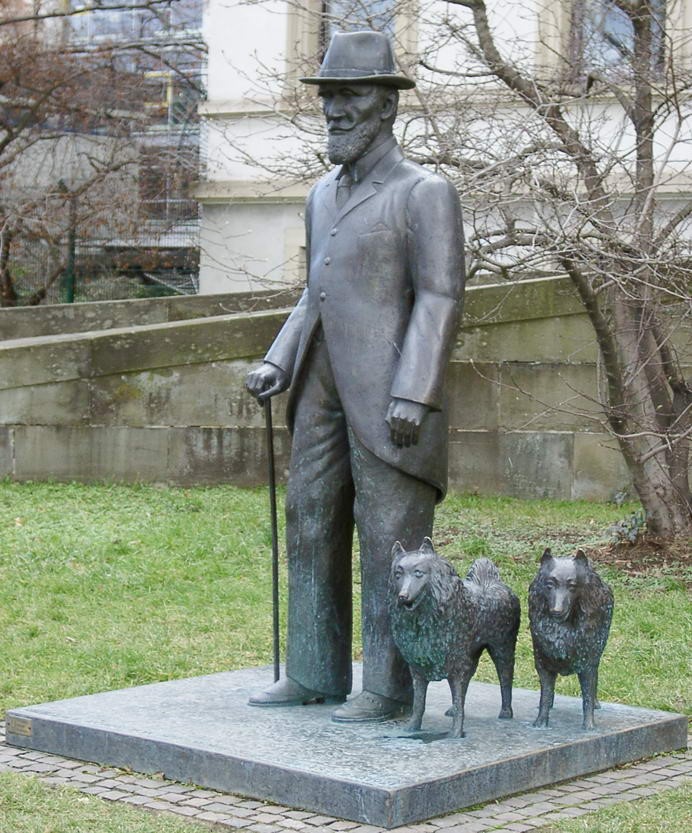
Probably the only monarchical statue erected in post-war Germany and a late triumph for a king whose removal in 1918 still gave some Stuttgarters pangs of guilt seventy years later: King Wilhelm II with his Spitz dogs (Hermann-Christian Zimmerle, 1991) – Image: Klaus Enslin
As it turned out, though, the citizens of Württemberg were not asked and – probably because of that – the country’s monarchy meekly had to yield to the revolutionary current that washed away all of Germany’s crowns in November 1918. It seems, though, that, when it came to the removal of King Wilhelm II, the revolutionaries’ hearts were not really in it. When, on 8 November Arthur Crispien, a leader of the Independent Social Democrats in Württemberg bumped into a group of workers who were noisily demonstrating outside the king’s palace, he snarled at them to leave the old man, who had done nobody any harm, in peace. After that dressing down, they dispersed. So while it may no longer have been the case that Count Eberhard’s last successor could calmly rest his head in the lap of each of his subjects, there was still enough Swabian loyalty left that even his enemies wanted him to enjoy a good night’s sleep.
Further Reading:
The essay is mainly based on original sources examined in libraries and archives in Stuttgart, Munich and Berlin. I am particularly grateful to Dr Albrecht Ernst (Hauptstaatsarchiv Stuttgart) for sharing some of his important new findings with me.
- Im Lichte neuer Quellen: Wilhelm II. Der letzte König von Württemberg. Katalog zur Ausstellung. Bearb. v. Albrecht Ernst (Stuttgart, 2015)
- Frank Lorenz Müller: „The German Monarchies“, in: M. Jefferies (ed.), The Ashgate Research Companion to Imperial Germany (Farnham, 2015), 55-73
- Inge Nunnenmacher: Literatur als Denkmal (http://www.goethezeitportal.de/wissen/illustrationen/balladen/literatur-als-denkmal-die-eberhardsgruppe-im-stuttgarter-schlossgarten.html)
- Paul Sauer: Württembergs letzter König. Das Leben Wilhelms II. (Stuttgart, 1994)
[1] Im Lichte neuer Quellen: Wilhelm II. Der letzte König von Württemberg. Katalog zur Ausstellung. Bearb. v. Albrecht Ernst (Stuttgart, 2015), 42.
[2] Dem Gedächtniß Ihrer Königlichen Hoheit der frühvollendeten Frau Prinzessin Wilhelm von Württemberg (Ludwigsburg, 1883).
[3] Wilhelm II. König von Württemberg. Ein Lebensbild (Ludwigsburg, 1891), 27-28.
[4] Im Lichte neuer Quellen: Wilhelm II. Der letzte König von Württemberg. Katalog zur Ausstellung. Bearb. v. Albrecht Ernst (Stuttgart, 2015), 45.
[5] Ute Frevert: Gefühlspolitik. Friedrich II. als Herr über die Herzen (Göttingen, 2012), 16.
[6] Tim Ostermann, Die verfassungsrechtliche Stellung des Deutschen Kaisers nach der Reichsverfassung von 1871 (Frankfurt, 2009), p. 234.
[7] Hans Boldt, ‘Der Föderalismus im Deutschen Kaiserreich als Verfassungsproblem’, in Helmut Rumpler (ed.), Innere Staatsbildung und gesellschaftliche Modernisierung in Österreich und Deutschland 1867/71-1914 (Vienna and Munich, 1991), p.34.
[8] Since King Karl had no children, Wilhelm was heir-presumptive even though they were only distantly related: Wilhelm’s father Friedrich and King Karl were first cousins.


